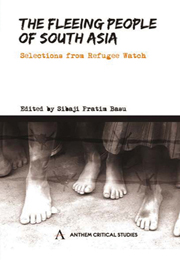Book contents
- Frontmatter
- Contents
- Acronyms and Abbreviations
- Foreword by Ranabir Samaddar
- Preface
- ETHICAL ISSUES
- LAWS
- SOUTH ASIA
- Introduction
- Refugees in South Asia: An Overview
- Internally Displaced Persons in Sri Lanka
- A Matter of Ethnicity
- Scrutinizing the Land Resettlement Scheme in Bhutan
- The Taliban Shelter Seekers or Refugee Warriors?
- Afghan Refugees head for Tajikistan, holed up in the Pamir Mountains
- Impact of International Jurisdiction on Afghan Refugee Rights
- Development Induced Displacement in Pakistan
- On the Trail of Burma's Internal Refugees
- Assault on Minorities in Bangladesh: An Analysis
- Neoliberal Globalization and Women's Experiences of Forced Migrations in Asia
- Who Went Where and How are They Doing? Pakistanis and Indians Outside South Asia
- INDIA
- GENDER
- INTERVIEW/CORRESPONDENCE
- REPRESENTATIONS
- Index
Who Went Where and How are They Doing? Pakistanis and Indians Outside South Asia
from SOUTH ASIA
Published online by Cambridge University Press: 05 March 2012
- Frontmatter
- Contents
- Acronyms and Abbreviations
- Foreword by Ranabir Samaddar
- Preface
- ETHICAL ISSUES
- LAWS
- SOUTH ASIA
- Introduction
- Refugees in South Asia: An Overview
- Internally Displaced Persons in Sri Lanka
- A Matter of Ethnicity
- Scrutinizing the Land Resettlement Scheme in Bhutan
- The Taliban Shelter Seekers or Refugee Warriors?
- Afghan Refugees head for Tajikistan, holed up in the Pamir Mountains
- Impact of International Jurisdiction on Afghan Refugee Rights
- Development Induced Displacement in Pakistan
- On the Trail of Burma's Internal Refugees
- Assault on Minorities in Bangladesh: An Analysis
- Neoliberal Globalization and Women's Experiences of Forced Migrations in Asia
- Who Went Where and How are They Doing? Pakistanis and Indians Outside South Asia
- INDIA
- GENDER
- INTERVIEW/CORRESPONDENCE
- REPRESENTATIONS
- Index
Summary
THE BEGINNING
In the space of a few months during the partition of India in 1947, 20 million people were displaced, 1 million died, 75,000 women were said to have been abducted, raped and families were divided, properties lost, homes destroyed and countries (India and Pakistan) exchanged.1 Excluding the internally displaced, today South Asia has the fourth largest concentration of refugees in the world. Going back to the 1940s, partition's refugees/migrants during the last five decades have had a long and complex history in the course of reaching respective homelands, some of them more than once (in the 1940s–1960s and then from the 1970s onwards) and some of them found themselves disowned by it in 1971 when Bangladesh came into being. […]
By December 1951, 6,597,000 refugees had moved from India to West Pakistan, and 7,94,127 refugees moved to what was then East Pakistan. Of the Indian Muslims headed for Pakistan during 1947–8, 95.9 per cent of the migrants from Assam, West Bengal and Bihar moved to East Pakistan and 3.2 per cent to Karachi. According to the 1951 census, 66.69 per cent of the migrants in East Pakistan came from West Bengal, 14.50 per cent from Bihar, 11.84 per cent from Assam and 6.97 per cent from other places in India. A passport and visa scheme was introduced only on 15 October 1952. But travel documents were not even required until 1953–4, several years after India and Pakistan became two separate countries.
- Type
- Chapter
- Information
- The Fleeing People of South AsiaSelections from Refugee Watch, pp. 207 - 222Publisher: Anthem PressPrint publication year: 2009



